

Audio By Carbonatix
As you step into Moxie Coffee Co.’s crisp, modern space, the smells of coffee, milk and fresh bread greet you. Sunlight cascades over 16th Street and through the midtown cafe’s shaded windows. An energetic indie playlist hums over the voices of girls on a group trip and workers click-clacking on their laptops.
Dads sip single-origin brews while their kids gnaw croissants, perched in robin’s egg chairs around long oak tables. Baristas buzz behind the coffee bar and breeze through the cafe when they drop off steaming earthenware mugs for regulars they know by name.
In many ways, Moxie is the portrait of Phoenix’s robust coffee scene. It’s cultured with a low-key vibe — the sort of place where you can order a reserve pour-over or an Instagram-worthy latte topped with a torched marshmallow.
At the heart of the shop is owner Matt Heltzel. On a warm fall morning, he takes a seat in the cafe with a mug of coffee and a sticky cardamom bun. His hair is tightly cropped and he sports a Moxie T-shirt with the shop’s cobalt blue logo of a Kintsugi-esque coffee cup. He loves talking about the farms where he sources his beans or about how fermentation imbues coffee with complex flavors.
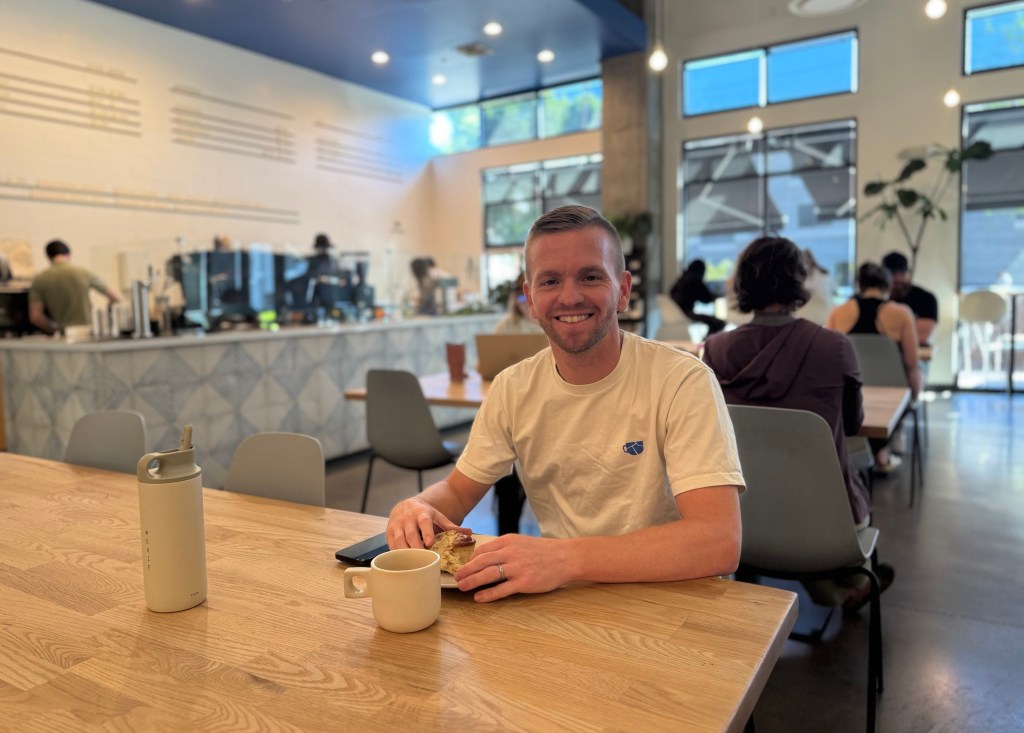
Sara Crocker
But top of mind lately are the costs. When the conversation turns to prices, Heltzel’s breezy demeanor turns more serious. He picks at the pastry in front of him.
“It’s a little bit of a scary time,” he says.
Around the Valley, as around the country, cappuccinos and cold brews are getting more expensive. In conversations with a half dozen roasters and cafe owners throughout the scene, tariffs were an easy culprit for the rise. Since the spring, President Donald Trump has slapped hefty tariffs on many imports, forcing American companies — and by proxy, consumers — to pay outsized taxes. Trump hit the world’s largest coffee producers, Brazil and Vietnam, with import taxes of 50% and 20%.
Yet it turns out tariffs are just the capper on a hellish year. Coffee prices were near all-time highs even before Trump’s taxes walloped roasters and coffee shop owners.
Shuffling past WhatsApp alerts from farmers and email notifications on his phone, Heltzel pulls up a graph tracking coffee bean prices. A line jitters up and down before bolting upward. In the past 12 months, the cost of coffee on the world market has skyrocketed, driven by rising demand and climate change that keeps wrecking crops.
“It’s at least double what coffee, for me as a roaster, has ever cost,” Heltzel says.
Those historic highs coupled with the double whammy of tariffs could soon cut a swath through the independent coffee scene, he says. If you’re a coffee drinker in the Valley, you’re bound to notice and maybe even watch your spending at cafes like Heltzel’s, if you haven’t already.
“I know many, many (coffee shops) who are desperately struggling and kind of on their last breath,” he says.
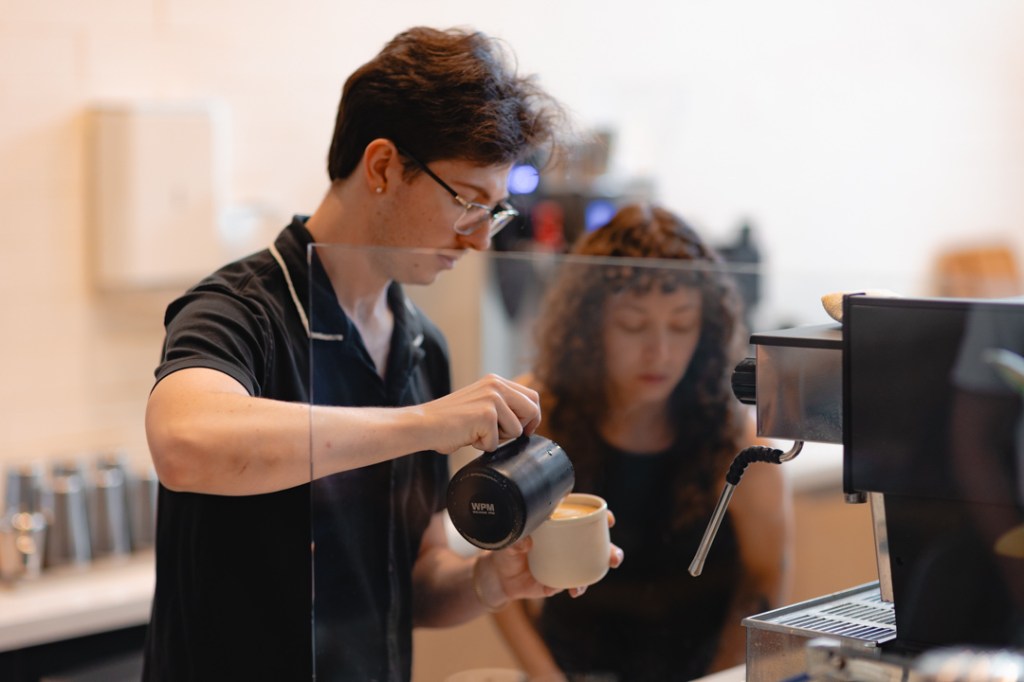
Brigette Doby
Global coffee prices spike
Current prices be damned, the global thirst for coffee has been growing for years. Some dire knock-on consequences have followed.
In Brazil, which grows more than a third of the world’s coffee, farmers since 2001 have razed millions of acres of Amazonian forests (an area the size of Honduras) to make way for plantations. A report this month by industry watchdog Coffee Watch notes that deforestation disrupts the rain that coffee depends on. In the past four years, frost and severe drought in Brazil have turned coffee plants brown and brittle. In Vietnam, heatwaves followed by heavy rains drowned plantations and disrupted harvests.
The loss of forests is “killing rains and leading to crop failures,” Etelle Higonnet, Coffee Watch’s director, said in the report. It’s creating a vicious cycle: Crop failures will only drive up the price of coffee further, enticing farmers to cut down more forests.
Coffee Watch’s report cautions that costs will keep rising if deforestation, and the climate disruption it causes, continue. “Rains are failing where coffee expands at the expense of forests,” the report said. “As a result, climate shocks are hitting wallets.”
Arabica coffee bean futures, the global benchmark for coffee prices, show the fallout. Flagging harvests and high demand have driven up prices before: In 2011, coffee commodity prices topped $3 per pound for the first time since 1977. By October 2020, with the pandemic in full swing, they sank to about $1 per pound. This year, they hit an all-time high of $4.41 per pound.
Bags, tins and K-cups of coffee lining the grocery store shelves are now nearly 19% more expensive than last year, per the latest Consumer Price Index report, which tracks how prices change with everyday goods like food, gas and clothing. Coffee shops, cafes and restaurants are begrudgingly following suit and raising prices.
American consumers may shrug their shoulders about tariffs on steel and lumber. (How often, after all, do you expect to buy a new car or build a deck?) But most of us feel coffee tariffs every morning as we switch on a Mr. Coffee or pull into a Dutch Bros. drive-thru. Today, 66% of American adults start their day with a cup of joe, the National Coffee Association estimates.
The huge demand may be why, despite the challenges and growing costs, entrepreneurs keep betting on the coffee industry. That doesn’t mean they aren’t feeling the squeeze.

Peixoto Coffee Roasters
Julia Peixoto Peters honed her sharp sense of commodity and coffee shop prices by running Peixoto Coffee Roasters with her husband, Jeff Peters. The original location of Peixoto opened in downtown Chandler in 2015, but the owner’s family has been in the coffee trade for generations, cultivating the crop in the highlands of Minas Gerais, in Brazil’s coffee belt.
Peixoto Peters roasts and serves coffee that her company imports directly from her family’s farm. Though each of Peixoto’s cafes is a little different — Chandler’s location is more rustic; Gilbert and Phoenix have a modern polish — they all have a hominess about them. They reflect the warm energy from Peixoto Peters, who’s always quick to offer a smile and a kind word carried by the soft lilt of her Brazilian accent.
Getting beans from Brazil to Arizona is arduous. At the Peixoto family farm, harvesting starts around May and can continue into August, depending on the season. As workers pick gold- and rust-colored coffee cherries from the rows of trees planted neatly across the rugged land, Peixoto Peters hand-selects the best beans for the coming year. She tastes for rich flavors of dark chocolate and berries to make Peixoto’s Familia coffee, or sweeter notes for the roaster’s Honey coffee.
Once she makes her selections, the shop waits two to four months while the beans are processed and shipped some 5,000 miles. This year’s order of about 40,000 pounds of coffee will fill three or four shipping containers.
“It’s not for the faint of heart,” Peixoto Peters says. “We wouldn’t do it any other way, because it’s from our family. But it involves a lot more work, a lot more coordination on our part to get these mountains of coffee from Brazil all the way here.”
Reckoning with higher costs — at the farm, on transportation, on packaging and cups — Peixoto Peters increased the menu prices this past summer at her cafes in Chandler and Gilbert by 50 to 75 cents, or about 10%. When they raised the prices, Peixoto Peters and her husband shared a letter with customers to explain the higher costs their business faces. Her newest shop, which shares space with Chaconne Patisserie in downtown Phoenix, opened in September with the new prices.
“I think it’s a matter of time for everyone in the marketplace to do so,” she says. “Every component of coffee is seeing a price increase.”
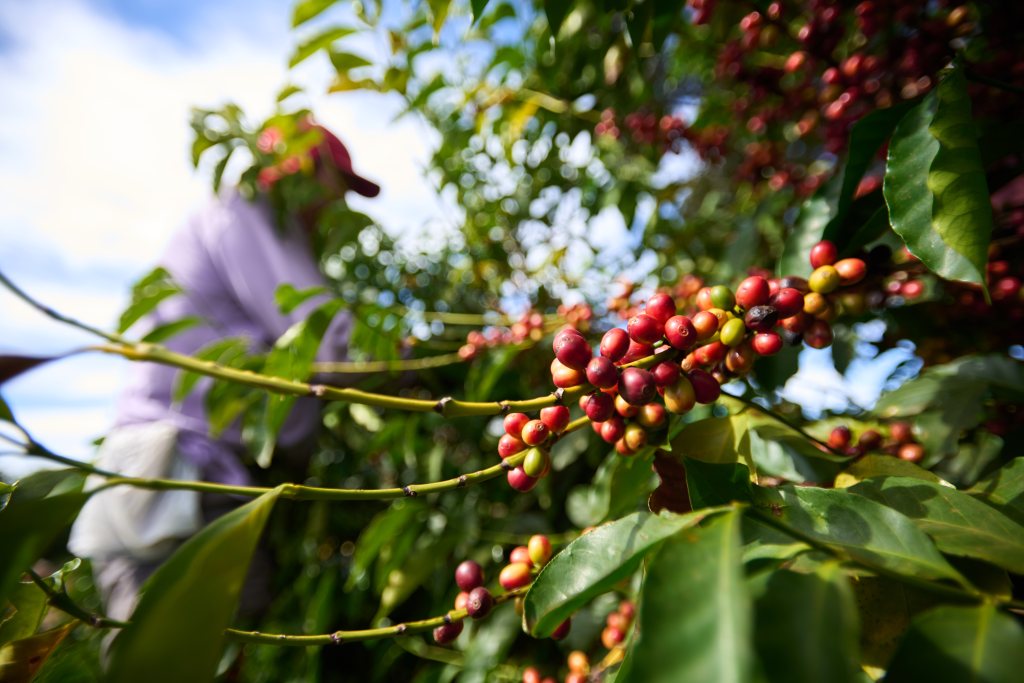
Peixoto Coffee Roasters
Over the past two decades, Heltzel has built a network of relationships with farms in Guatemala, Colombia and Ethiopia that produce light-bodied coffees with fruit-forward flavors.
He points to the Guatemalan beans mounded in a hopper on Moxie’s coffee bar, which are used for espresso drinks. Two years ago, Heltzel bought those beans for $4.10 per pound. Today, a pound costs $6.10, or 33% more.
He hasn’t raised prices to match his higher costs — yet. You can still get a drip coffee for $3.50 or a latte for $5.25. Customers don’t get upcharged for trading dairy for almond or oat milk.
“Coffee’s an attainable luxury, but only to a certain price point,” Heltzel says. “Then you price yourself out of the market, and then your business is over.”
Moxie’s menu prices will increase by 25 to 50 cents per drink later this year. Heltzel has already increased retail prices on bags of coffee by around 5 to 10%. Raising those prices doesn’t feel good.
“I didn’t design this to just be a place that only rich people come,” he says.
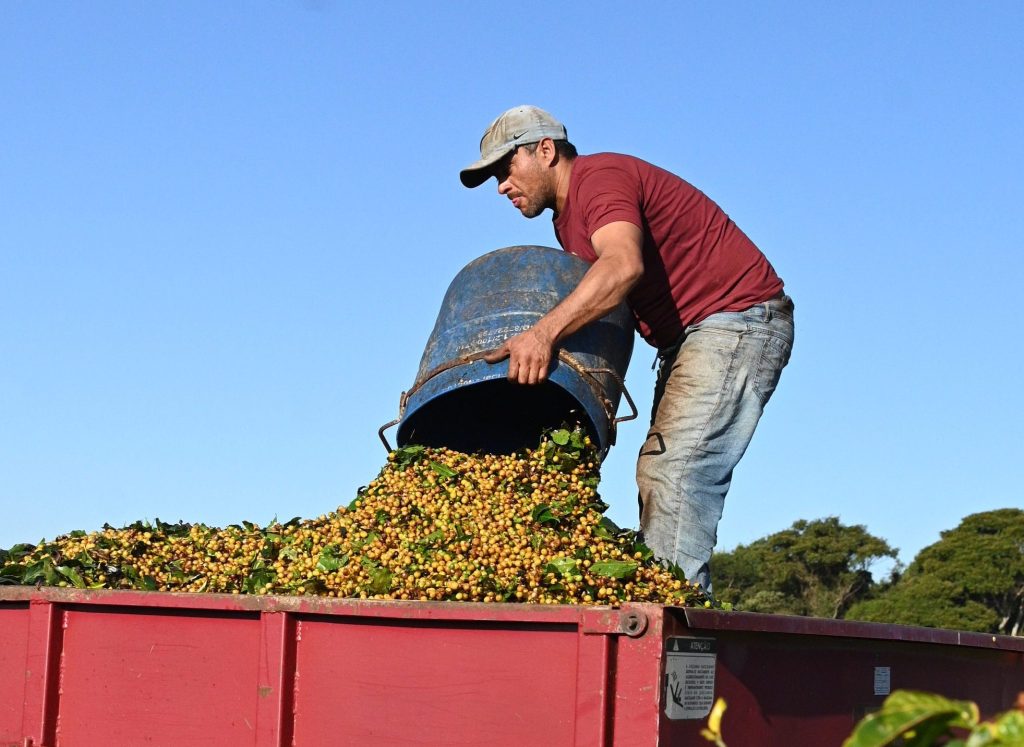
Peixoto Coffee Roasters
Planning for tariffs
Climate change is a slower, more gradual problem than tariffs. But Trump has proven to be no less mercurial than patchy Amazon rains. He argues that tariffs encourage jobs and goods to be made on U.S. soil. Maybe that’s true in the case of certain goods. In the case of coffee, American-grown can’t begin to fill the demand. Only Hawaii, California and Puerto Rico have a climate to cultivate coffee. Together, those places grow just 1% of the world’s supply, far less than Americans drink.
Americans gulp three cups of coffee each day, on average, though Arizonans drink less. While that’s still a bona fide caffeine addiction, the U.S. ranks 25th in the world for coffee consumption. We can’t hold a candle to coffee drinkers in northern European and Scandinavian countries who knock back as many as five coffees a day.
Coffee drinkers in the global north can get their fix only via international trade. Tariffs on coffee, then, pose a serious threat to business, at least for now. Trump signed an executive order in September that would designate coffee as a commodity that may be exempt from tariffs, following the logic that the U.S. can’t grow its own. Congress is also weighing a bill called the No Coffee Tax Act that would repeal tariffs on most coffee products and apply retroactively to duties since Jan. 19. And the Supreme Court in November will consider a case that questions the president’s ability to unilaterally impose tariffs at all.
Until help arrives, coffee shop owners who would rather focus on brews and blends instead obsessively track global trade.
Tariff red tape has forced roasters to contend with delayed and destroyed shipments. Heltzel says he paid a $700 duty on a box of coffee two days ahead of a deadline, only to receive an email from the shipping company that his package had been returned to sender. His tariff payment remains unaccounted for.
“It’s kind of a nightmare to figure out who to get in contact with to get refunded or how do I get a refund? Are they refunding?” he says. “No one really knows.”
Others are playing a game of chicken to keep costs low. Peixoto Peters says she can wait until the end of the year to import her annual batch of coffee from Brazil, on the chance that coffee tariffs ease soon.
“The risk is high,” she says. “But I’m remaining optimistic that something like an exemption will be worked out.”

Sara Crocker
Some roasters are making changes in real time. Blake Beal, who owns Phoenix’s Beal Beans Roasting Co. with his wife, Pashlee Grimmett, has dropped Brazilian beans from his coffee blends to avoid tariffs. He’s also moving away from Sumatran coffees because of high tariffs on Indonesian products.
Much like a sommelier, Beal builds a list of pour-over coffee selections from a variety of roasts and regions. The lanky roaster, who sports curly hair and black-rimmed aviator glasses, is keen to tell the stories of the people who grow the beans as he delicately pours water over grounds at the warm wooden bar of his industrial Sunnyslope cafe.
Beal used to roast and serve as many as nine different coffees. Today, he focuses only on closer, lower-tariffed countries like Honduras and Guatemala and sources beans from small farms committed to sustainable and organic growing practices. The reality, he says, is coffee has been cheap for too long and hasn’t always fairly compensated the people who grow it. Higher prices reflect, in part, economic fairness.
“I honestly wish coffee was more cheap,” Beal says. “But this is, in a lot of ways, what it should cost. That’s kind of a hard reality.”
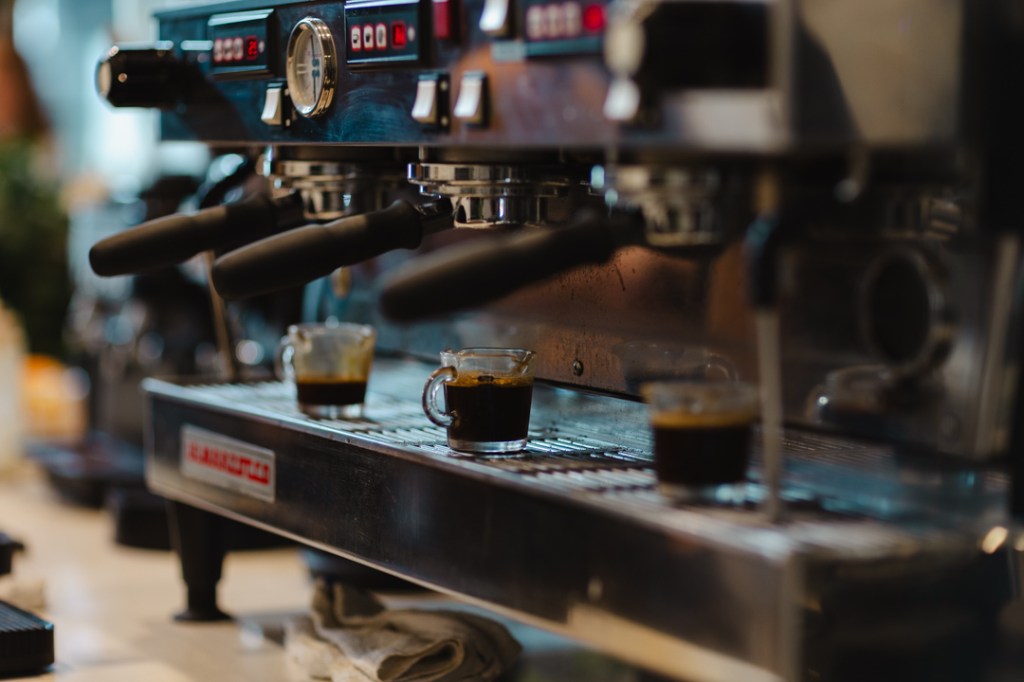
Brigette Doby
Keeping coffee affordable
Tariffs have forced coffee shop owners to walk a tightrope. They must balance costs against what customers can afford, or are willing to pay. No matter how essential a cup of coffee sounds, quick math says that the difference between a $3, $5 and an $8 cup, plus tip, adds up in a hurry, especially if it’s a habit.
James Holmstol visits Moxie almost every day. He orders matcha with almond milk; if his partner is with him, she gets a coffee.
“I don’t like getting coffee to go,” he says. “I like the ritual of sitting and enjoying it.”
Holmstol, a consultant who helps endurance athletes eat and train, typically works from Moxie as he sips his drink. He likes the atmosphere and comfort of being a regular. But he’s sensitive to the price of his order: just over $7.
When he stops somewhere else and has to pay more than that, he starts to wonder, “What am I getting?”
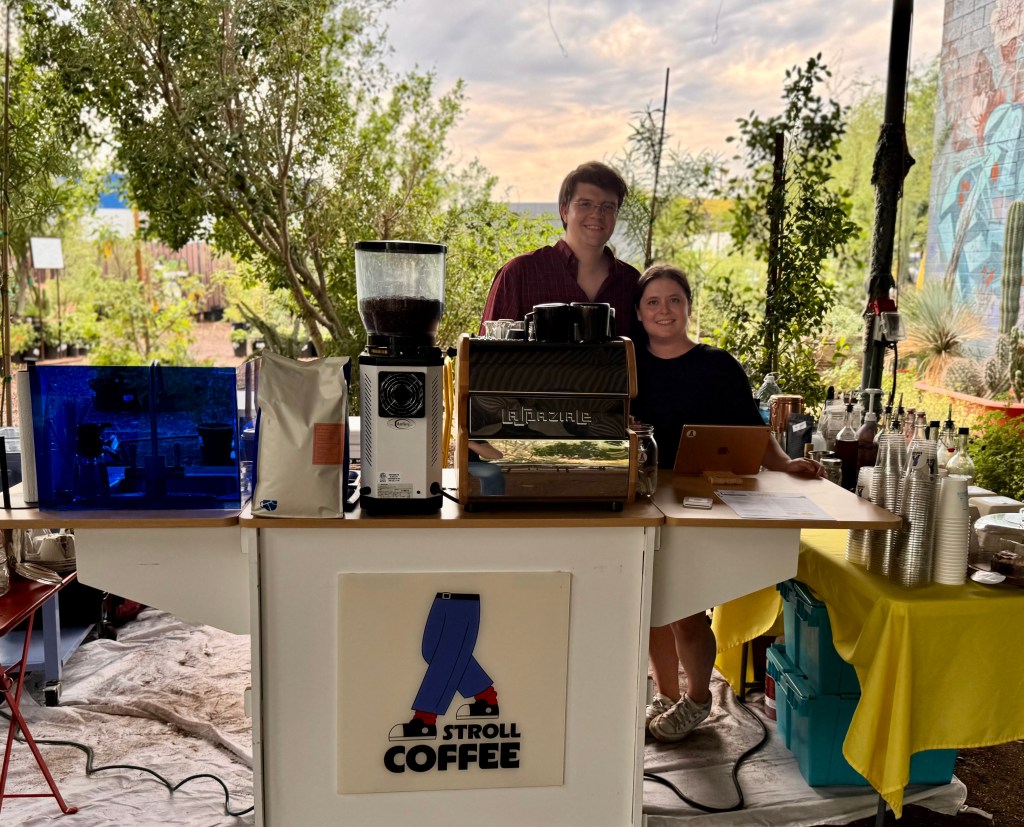
Sara Crocker
That feeling is what Ty Watson, another Valley coffee seller, calls a “balking point.”
She worked in marketing for a local coffee chain before founding a mobile coffee cart, Stroll Coffee, with her husband, Freddie Watson, in December. Freddie applies bar techniques like clarification — a laborious process also referred to as milk-washing — to create a crystal clear, velvety smooth coffee drink. Over the summer, the cart served a tropical, Dole Whip-inspired clarified coffee made with Moxie’s cold brew.
The Watsons found that customers forgive higher prices when the owners explain their commitment to laborious techniques, hand-made syrups and buying locally. Still, they won’t put a drink over $9 on the menu.
“The last thing I want to do to anyone while they’re having a nice little day out is, you know, kind of rob them in daylight,” Freddie says.
Beal, who opened his specialty coffee shop in July after spending five years brewing and roasting coffee at farmers’ markets, agrees with that sentiment.
“We all struggle with the thought of a $10 cup of coffee,” Beal says. “Coffee has become such a huge part of our ritual and our society and our humanity in some ways.”

Brigette Doby
Brewing new ideas
Decades of cheap labor and predictable climates conditioned us all to undervalue coffee. It’s always been a luxury good in plain sight: nutritionally vapid, imported across oceans, brought to us by fabulous chemistry and unseen human hands. Yet it’s also a staple. So as prices keep ballooning, cafe owners are trying to maintain their margins without pricing you out of your double espresso.
Mythical Coffee Roasters in Gilbert hosted wood-fired pizza nights with the pop-up Irma. Co-owner Eric Hervey manned the coffee bar, serving sparkling teas and lattes and pulling shots for affogatos during a recent evening. Hervey runs the coffee shop with his wife, Kat, typically from 7 a.m. to 4 p.m. daily. Hosting evening events allows the Herveys to invite customers in for more hours. At an Irma pop-up, dozens of guests packed the cafe’s benches and tables inside or shared community tables set up outside.
“Margins are tighter,” Hervey says. “If we can do one extra evening, maybe that could shift towards a little bit better business model.”
Moxie will soon launch a membership program similar to a wine club. Members will be invited to coffee classes, where they can meet producers and taste unique brews. Heltzel also moved Moxie’s roastery from the cafe to the downtown Phoenix warehouse district, allowing the roastery to grow and Heltzel to revamp the cafe space as a kitchen for baker Ryne Spracale, who is currently piloting morning buns and cookies. By next spring, that menu will include sandwiches and loaves of bread.
“We’re starting our own bakery operation so that we can own that,” Heltzel says. “We can own our margins, we can own the product and the product quality.”
While rising costs and tariffs squeeze the coffee industry, they could be devastating for small businesses. Heltzel hopes consumers will pay attention to this economic volatility. A large coffeehouse chain can weather these storms. A locally owned cafe may not.
“It does feel like an important time for people to sit down and vote with their wallet,” he says. “Choosing those will have a really important impact on the businesses that will exist in the next two or three years.”